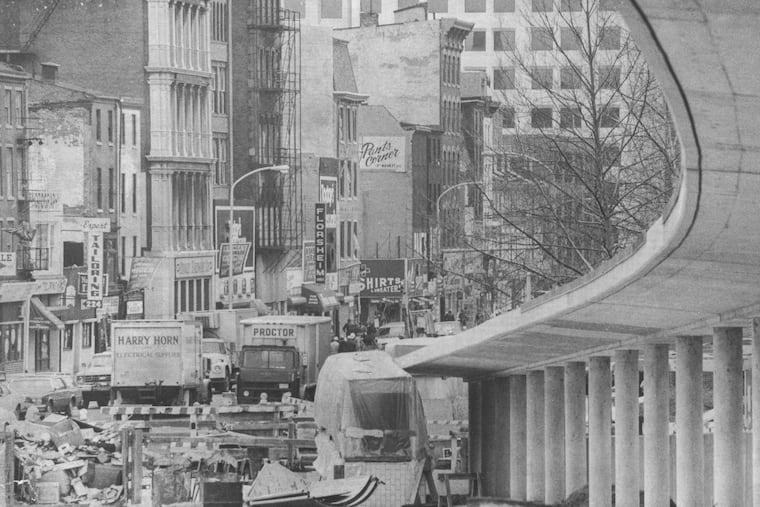Comcast’s Sports Complex plan for South Philly would make our city less livable
I have fought these terrible projects in Philadelphia before, and I will fight them again. Rather than striving to accommodate more and more cars, Philadelphia should make transit more accessible.

Earlier this year, Comcast Spectacor presented a large plan for the South Philadelphia Sports Complex that would create one of the biggest parking garages in the country, without even mentioning transit improvements or pedestrian facilities. If this plan is built, it would increase congestion in Center City and bring with it all the problems of car-based cities.
Philadelphia should not plan any additional lanes on radial freeways like I-95, nor large parking facilities like those proposed at the Sports Complex. To do so would take our city backward.
I have fought these terrible projects in Philadelphia before, and I will fight them again.
Having worked in urban planning for more than 50 years, I have a long view of this subject. From 1950 to 1990, most transportation planning had the goal of accommodating as many passenger cars and trucks as possible in growing metropolitan areas. The lobbies of auto manufacturers, oil, and tire companies destroyed streetcar networks, made public transit less attractive, and considered pedestrians as obstructions to vehicle travel.
In recent decades, it has become clear that cities designed for cars have been a failure for several reasons. First, expressways and freeways represent physical, visual, and environmental obstacles. Second, they are not pedestrian-friendly; in many cities, travel is easier by transit or walking than by car. Most importantly, studies show that car-based cities in the U.S. have greater traffic congestion and longer travel times for drivers to reach destinations than cities that have limited freeways and major transit systems.
In recent decades, an increasing number of cities — including Calgary, Alberta, Munich, Portland, Ore., San Francisco, Singapore, Toronto, and Vienna — have moved away from car-centric planning and toward a model of “livable cities,” where transit systems, pedestrians, and bicycles are valued over cars. Residents and visitors in livable cities feel safer and enjoy walking instead of escaping from streets into garages.
This model is not only good for the environment but also for the economy. Livable cities have central business districts with pedestrians walking to stores, offices, museums, concert halls, and tourist attractions. Some cities — Singapore, London, Stockholm, and Oslo, Norway — control traffic by road pricing, meaning tolls around city centers reduce traffic and decrease congestion. These tolls vary in price by increasing cost when the number of vehicles increases, thus preventing congestion. New York City is currently considering this strategy. Many cities also have pedestrian streets served by light rail transit, such as Buffalo, N.Y., Oslo, and Karlsruhe, Germany.
Philadelphia did not have a dense network of freeways in the mid-1960s. However, in 1968, the Delaware Valley Regional Planning Commission published a plan that recommended building a dense freeway network, changing City Avenue, 52nd Street, Girard Avenue, Lansdowne Avenue, and South Street into freeways, tearing down many blocks of residential buildings, and requiring many multistory parking garages.
We at the University of Pennsylvania published a sharp critique of the plan in 1969. We criticized the plan for its “Los-Angelization” of the people-oriented, historic Philadelphia area. Its plan for transit lines also underestimated the need for new rail lines. Our critique was used in many discussions about suspending freeways and shifting some funds for SEPTA’s projects.
In the 1980s, similar controversies questioning the construction of many urban freeway networks and neglect of transit took place in many other cities. They culminated in the signing of the 1991 Intermodal Surface Transportation Efficiency Act, a progressive federal law. In the following years, all of the proposed freeways in our area were canceled.
In 1994, PennDot proposed construction of an elevated four-lane roadway above I-95, parallel with Penn’s Landing. Again, I pushed back by cowriting an essay for The Inquirer titled, “New highways add to congestion.” This included numerous examples of problems with car-based cities, and efforts to change transportation networks.
At the same time Philadelphia was proposing an even bigger highway, other cities were tearing down freeways for the benefit of pedestrians and public transit. Eventually, The Inquirer reported that the Delaware Valley Regional Planning Commission rejected the proposed I-95 elevated roadway plan.
The Comcast Spectacor plan for South Philly is giving me déjà vu.
Rather than striving to accommodate more and more cars, Philadelphia should make transit more accessible and attractive.
I fear we are falling behind. In recent decades, many of our peer cities — such as Los Angeles, San Francisco, Washington, D.C., and Salt Lake City — have built many more rail transit lines. We should protect and improve Philadelphia’s livability by following their example.
Vukan R. Vuchic is professor emeritus of transportation systems engineering and city and regional planning at the University of Pennsylvania.